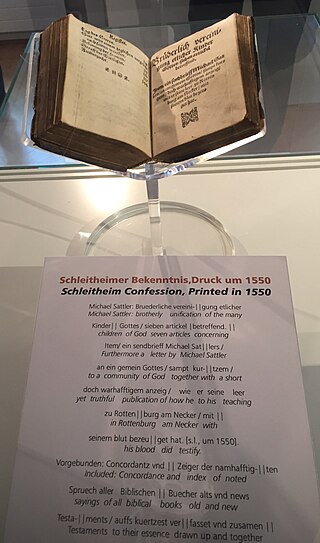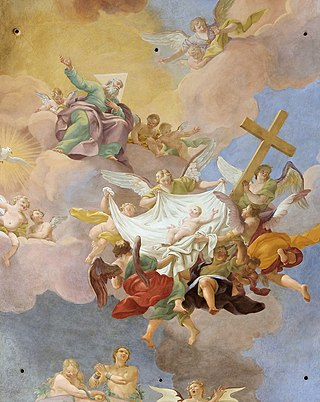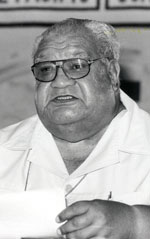Related Research Articles

Transubstantiation is, according to the teaching of the Catholic Church, "the change of the whole substance of bread into the substance of the Body of Christ and of the whole substance of wine into the substance of the Blood of Christ". This change is brought about in the eucharistic prayer through the efficacy of the word of Christ and by the action of the Holy Spirit. However, "the outward characteristics of bread and wine, that is the 'eucharistic species', remain unaltered". In this teaching, the notions of "substance" and "transubstantiation" are not linked with any particular theory of metaphysics.

God the Father is a title given to God in Christianity. In mainstream trinitarian Christianity, God the Father is regarded as the first Person of the Trinity, followed by the second person, Jesus Christ the Son, and the third person, God the Holy Spirit. Since the second century, Christian creeds included affirmation of belief in "God the Father (Almighty)", primarily in his capacity as "Father and creator of the universe".
The emerging church, sometimes wrongly equated with the "emergent movement" or "emergent conversation", is a Christian movement of the late 20th and early 21st century. Emerging churches can be found around the globe, predominantly in North America, Western Europe, Australia, New Zealand, and Africa. Members come from a number of Christian traditions. Some attend local independent churches or house churches while others worship in traditional Christian denominations. The emerging church favors the use of simple story and narrative. Members of the movement often place a high value on good works or social activism, including missional living. Proponents of the movement believe it transcends labels such as "conservative" and "liberal"; it is sometimes called a "conversation" to emphasize its developing and decentralized nature, its range of standpoints, and commitment to dialogue. Participants seek to live their faith in what they believe to be a "postmodern" society. Disillusionment with the organized and institutional church has led participants to support the deconstruction of modern Christian worship and evangelism, and the nature of modern Christian community.

Anabaptist theology, also known as Anabaptist doctrine, is a theological tradition reflecting the doctrine of the Anabaptist Churches. The major branches of Anabaptist Christianity agree on core doctrines but have nuances in practice. While the adherence to doctrine is important in Anabaptist Christianity, living righteously is stressed to a greater degree.

Two names and a variety of titles are used to refer to Jesus in the New Testament. In Christianity, the two names Jesus and Emmanuel that refer to Jesus in the New Testament have salvific attributes. After the crucifixion of Jesus the early Church did not simply repeat his messages, but focused on him, proclaimed him, and tried to understand and explain his message. One element of the process of understanding and proclaiming Jesus was the attribution of titles to him. Some of the titles that were gradually used in the early Church and then appeared in the New Testament were adopted from the Jewish context of the age, while others were selected to refer to, and underscore the message, mission and teachings of Jesus. In time, some of these titles gathered significant Christological significance.
Christocentrism is a doctrinal term within Christianity, describing theological positions that focus on Jesus Christ, the second person of the Christian Trinity, in relation to the Godhead/God the Father (theocentric) or the Holy Spirit (pneumocentric). Christocentric theologies make Christ the central theme about which all other theological positions/doctrines are oriented.
Liberal Christianity, also known as liberal theology and historically as Christian Modernism, is a movement that interprets Christian teaching by taking into consideration modern knowledge, science and ethics. It emphasizes the importance of reason and experience over doctrinal authority. Liberal Christians view their theology as an alternative to both atheistic rationalism and theologies based on traditional interpretations of external authority, such as the Bible or sacred tradition.

Blood of Christ, also known as the Most Precious Blood, in Christian theology refers to the physical blood actually shed by Jesus Christ primarily on the Cross, and the salvation which Christianity teaches was accomplished thereby, or the sacramental blood (wine) present in the Eucharist or Lord's Supper, which some Christian denominations believe to be the same blood of Christ shed on the Cross.

Christian symbolism is the use of symbols, including archetypes, acts, artwork or events, by Christianity. It invests objects or actions with an inner meaning expressing Christian ideas.

In Christianity, God is the eternal, supreme being who created and preserves all things. Christians believe in a monotheistic, trinitarian conception of God, which is both transcendent and immanent. Christians believe in a singular God that exists in a Trinity, which consists of three persons: God the Father, God the Son, and God the Holy Spirit. Christian teachings on the transcendence, immanence, and involvement of God in the world and his love for humanity exclude the belief that God is of the same substance as the created universe but accept that God the Son assumed hypostatically united human nature, thus becoming man in a unique event known as "the Incarnation".
Aleamotuʻa was the 18th Tu'i Kanokupolu of Tonga, the third lineage of Tongan Kings with the political and military power who ruled in support of the Tu'i Tonga.

"Light of the World" is a phrase Jesus used to describe himself and his disciples in the New Testament. The phrase is recorded in the Gospels of Matthew (5:14–16) and John (8:12). It is closely related to the parables of salt and light and lamp under a bushel, which also appear in Jesus' Sermon on the Mount.
This is a glossary of terms used in Christianity.

Christianity is the predominant religion in Tonga, with Methodists having the most adherents.

The Pacific Conference of Churches (PCC) is an ecumenical organization representing Christian churches in the Pacific region. It seeks the visible unity of the church on issues of justice, peace and integrity of creation, initiatives on capacity building, and solidarity with its members during times of natural disasters and internal social upheavals.

The pre-existence of Christ asserts the existence of Christ prior to his incarnation as Jesus. One of the relevant Bible passages is John 1 where, in the Trinitarian interpretation, Christ is identified with a pre-existent divine hypostasis called the Logos. There are nontrinitarian views that question the aspect of personal pre-existence, the aspect of divinity, or both.
Christian theology is the theology – the systematic study of the divine and religion – of Christian belief and practice. It concentrates primarily upon the texts of the Old Testament and of the New Testament, as well as on Christian tradition. Christian theologians use biblical exegesis, rational analysis and argument. Theologians may undertake the study of Christian theology for a variety of reasons, such as in order to:

In Christianity the term "water of Life" is used in the context of living water, specific references appearing in the Book of Revelation, as well as the Gospel of John. In these references, the term Water of Life refers to the Holy Spirit.

The Last Adam, also given as the Final Adam or the UltimateAdam, is a title given to Jesus in the New Testament. Similar titles that also refer to Jesus include Second Adam and New Adam.

Sione ʻAmanaki Havea (1922–2000) was a Tongan Methodist minister and theologian, known for developing a contextual theology for the context of the Pacific Islands.
References
Footnotes
- ↑ Breward 2012, p. 227.
- ↑ Forman 2005, p. 115.
- 1 2 Carroll 2004, p. 75.
- ↑ Carroll 2004, p. 76.
- ↑ Palu 2012, pp. 69–70.
- 1 2 3 4 Prior 1993, p. 35.
- ↑ Prior 1993, p. 31.
- ↑ Prior 1993, pp. 32–34.
- ↑ Prior 1993, p. 34.
- ↑ Prior 1993, p. 36.
- ↑ Palu 2012, p. 77-79.
- ↑ Palu 2002, p. 72-73.
- 1 2 Prior 1993, p. 38.
- ↑ Forman 2005; Tuwere 2002.
- ↑ Forman 2005, p. 116.
- ↑ Carroll 2004, pp. 78–81.
- ↑ Carroll 2004, p. 81.
Bibliography
- Breward, Ian (2012). "Christianity in Polynesia: Transforming the Islands". In Farhadian, Charles F. (ed.). Introducing World Christianity. Malden, Massachusetts: Wiley Blackwell. pp. 218–229. ISBN 978-1-4051-8248-5.
- Carroll, Seforosa (2004). "Weaving New Spaces: Christological Perspectives from Oceania (Pacific) and the Oceanic Diaspora". Studies in World Christianity. 10: 72–92. doi:10.3366/swc.2004.10.1.72. ISSN 1750-0230.
- Forman, Charles W. (2005). "Finding Our Own Voice: The Reinterpreting of Christianity by Oceanic Theologians" (PDF). International Bulletin of Missionary Research. 29 (3): 115–122. doi:10.1177/239693930502900301. ISSN 0272-6122. Archived from the original on 15 June 2016. Retrieved 22 November 2017.
{{cite journal}}: CS1 maint: unfit URL (link) - Palu, Ma'afu (2002). The Quest for a Pacific Theology: A Re-consideration of its Methodology. Convention on Contextual Theology. Tonga. Retrieved 22 November 2017– via Academia.edu.
- ——— (2012). "Dr Sione 'Amanaki Havea of Tonga: The Architect of Pacific Theology" (PDF). Melanesian Journal of Theology. 28 (2): 67–81. ISSN 0256-856X . Retrieved 22 November 2017.
- Prior, Randall (1993). "I Am the Cocconut of Life: An Evaluation of Coconut Theology" (PDF). Pacific Journal of Theology. 2 (10). Suva, Fiji: South Pacific Association of Theological Schools: 31–40. ISBN 978-982-200-066-5 . Retrieved 22 November 2017.[ permanent dead link ]
- Tuwere, Ilaitia S. (2002). Vanua: Towards a Fijian Theology of Place. Institute of Pacific Studies and College of St John the Evangelist. ISBN 978-982-02-0338-9.